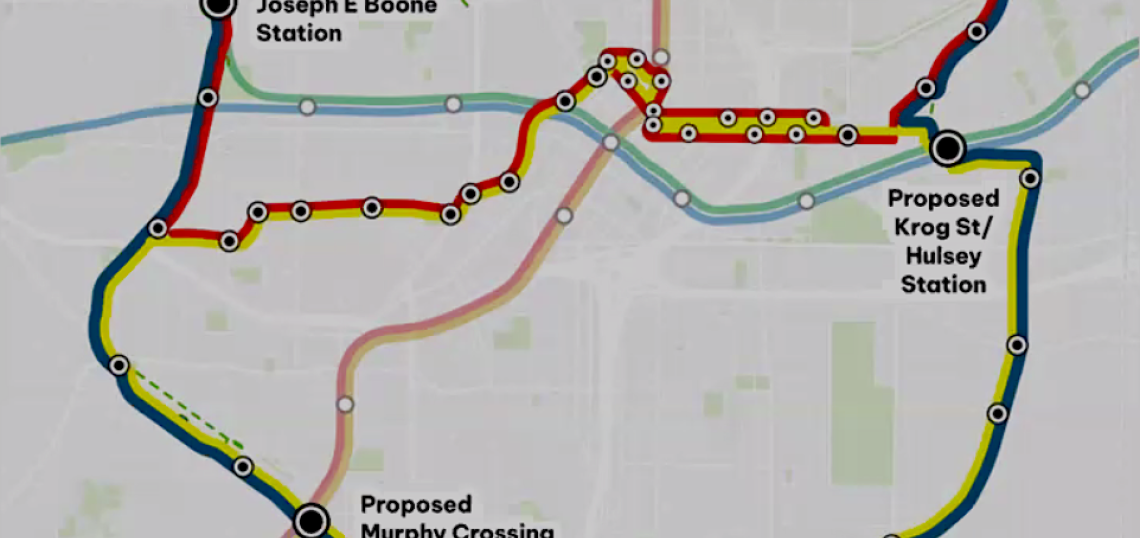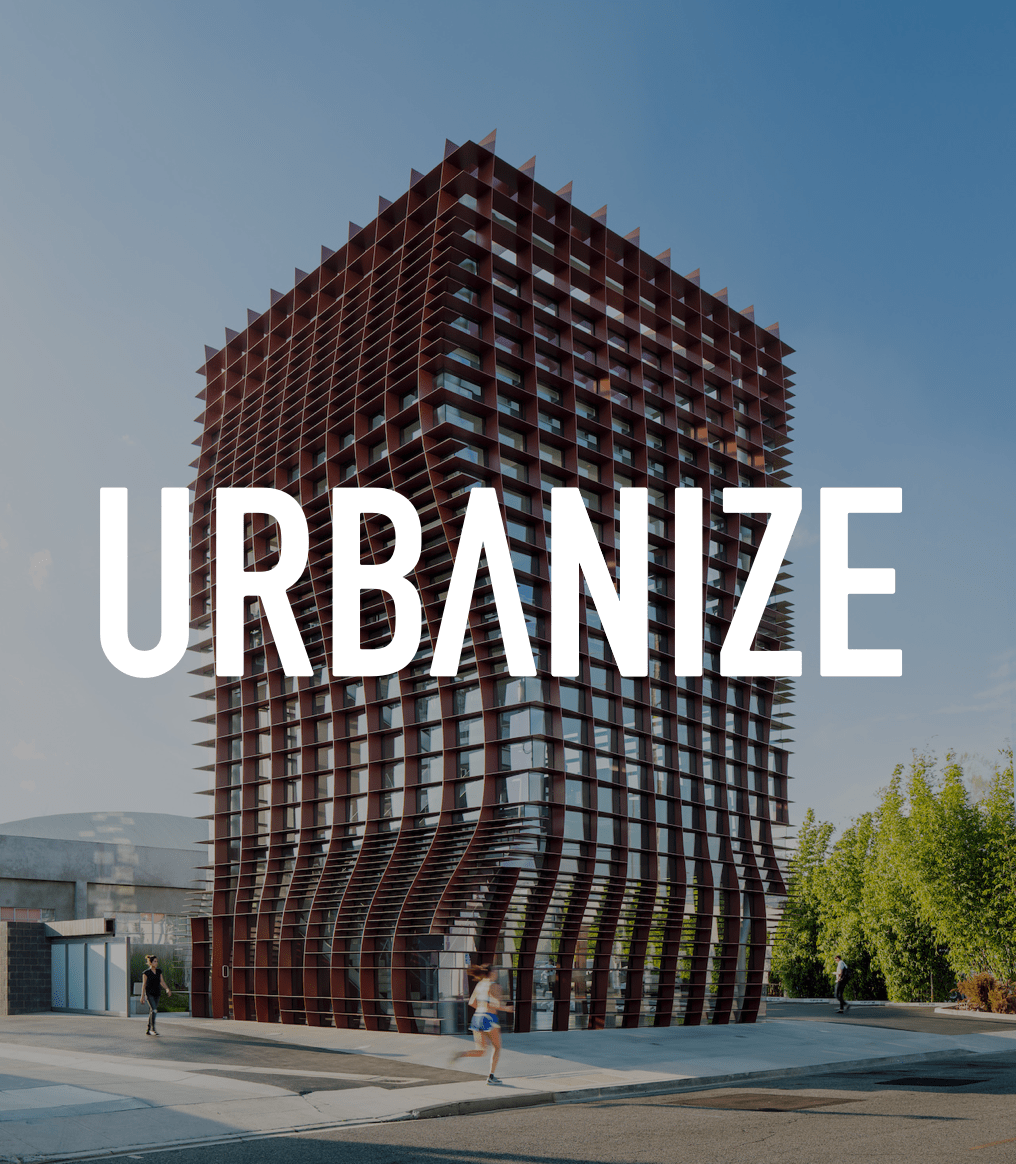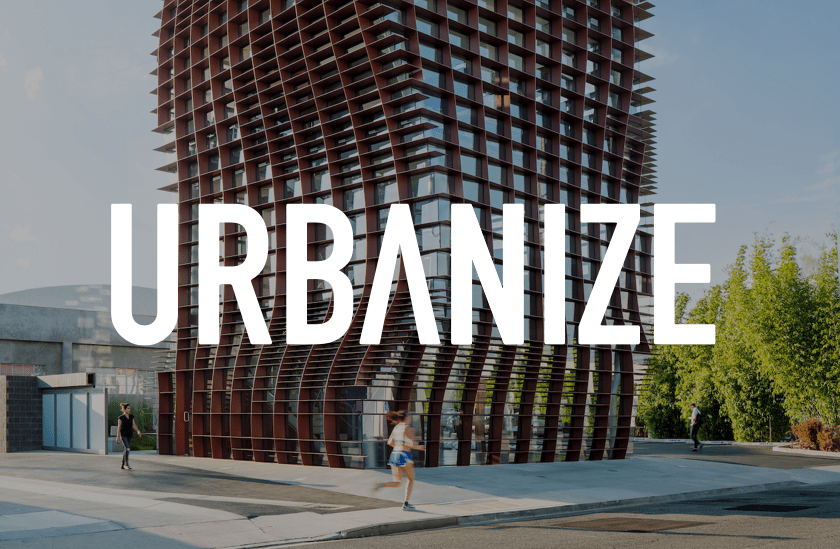Don’t expect Beltline transit vehicles to be zipping around the loop next year—or in the next couple of years.
But for transit enthusiasts, a Tuesday evening meeting could lend hope that Beltline light-rail mobility remains firmly on the table, despite decommitments from city officials, pushback from some neighbors, and the advent of alternatives such as Beltline driverless vehicles in other parts of town.
Nearly two years after a technical analysis and other work began in earnest, Beltline leadership hosted a citywide virtual meeting to update progress on its Beltline Transit Study. A tentative cost breakdown shows full implementation of transit would carry a price tag of roughly $3.5 billion, including $270 million for 42 vehicles.
The longest quadrant—the 5.5-mile Northwest section, where the Beltline doesn’t own right-of-way to build light rail yet—could cost $800 million alone, per today’s estimates. On the flipside of town, the relatively short two-mile Crosstown East section would carry a $400-million price tag, in part because it would include a large tunnel underneath Hulsey Yards, a vast slab of CSX Transportation-controlled land, as Shaun Green, the Beltline’s principal engineer, said Tuesday.
Green cautioned that all cost estimates are ballpark at this point, as just 5 to 10 percent of engineering design work has been completed on Beltline transit to date.
“It’s not going to be delivered overnight,” Green said. “The implementation plan is a work in progress, much to be done.”
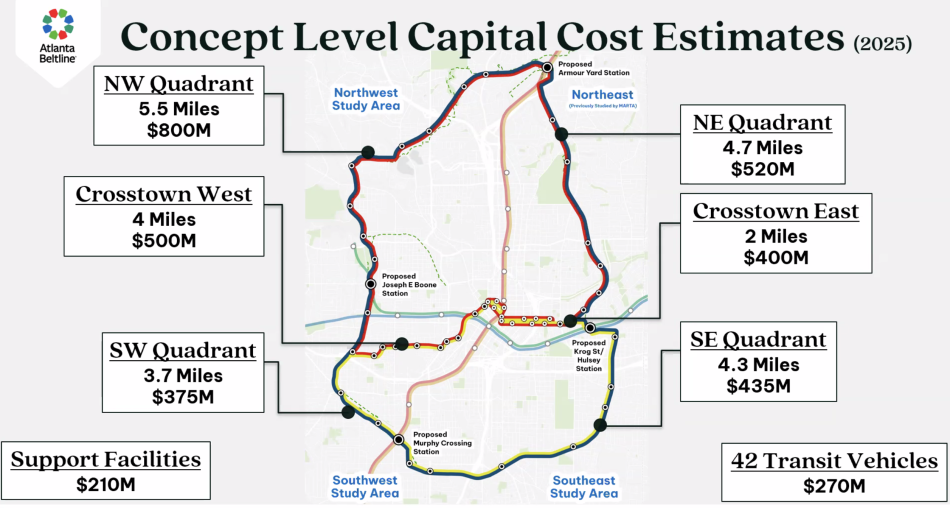 A rough 2025 breakdown of estimated costs to implement transit, purchase vehicles, and build required, ancillary infrastructure for Beltline rail. Atlanta Beltline Inc.
A rough 2025 breakdown of estimated costs to implement transit, purchase vehicles, and build required, ancillary infrastructure for Beltline rail. Atlanta Beltline Inc.
The Beltline’s presentation also included the agency’s draft recommendations for station locations, including 13 stops that would dot the Southwest and Southeast quadrants, where the Beltline owns the land.
Those locations could shift a bit, pending engineering studies, but on any section of the loop, plans call for customers to not wait more than a few minutes for transit vehicles headed in either direction.
“We don’t want to have a stop every quarter of a mile,” said Green. “It would take forever to get anywhere.”
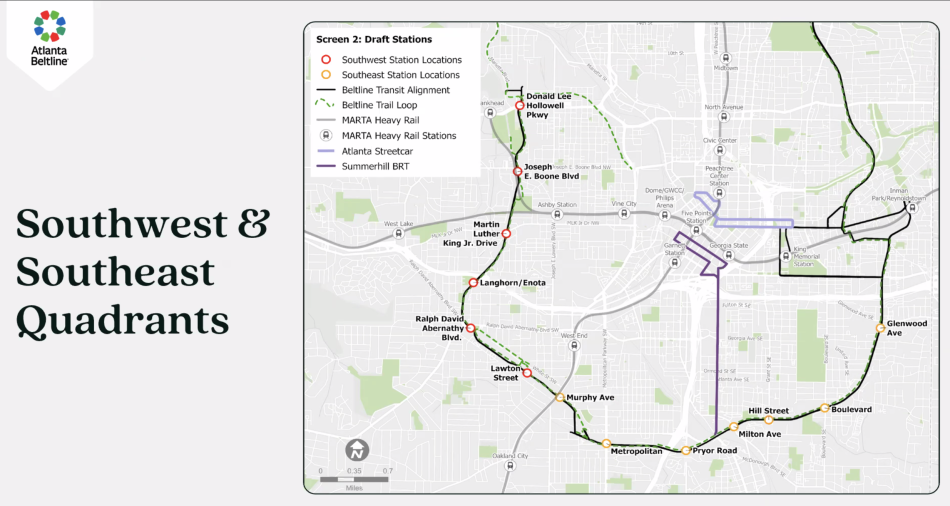 Tentative plans for routes and 13 station locations along the Beltline corridor's southern swoop. Atlanta Beltline Inc.
Tentative plans for routes and 13 station locations along the Beltline corridor's southern swoop. Atlanta Beltline Inc.
The Beltline also revealed its preferred route for the Northwest transit quadrant, where light rail would run from Bankhead up and around to the Lindbergh area—and where no existing rail corridor is in place for the Beltline’s use today. A key objective is to connect Piedmont Hospital, the largest employer near the Beltline loop, with transit, Green said. (One of five options studied called for light rail to leave the Beltline corridor and take a raised track on columns in the middle of Peachtree Road to the hospital and beyond, unencumbered by vehicle traffic; that option would be massively expensive and would change traffic flow—no more left turns into commercial centers, essentially—while also visually impacting the area, per Beltline officials.)
Instead, the Beltline is recommending that what’s known as the CSX Alignment be picked. It would run adjacent to the railroad company’s right-of-way and have just eight stops to more swiftly move passengers, though it wouldn’t be without drawbacks, per Green.
“This is the alignment that’s been out in the public sphere from the beginning of the Beltline,” he said.
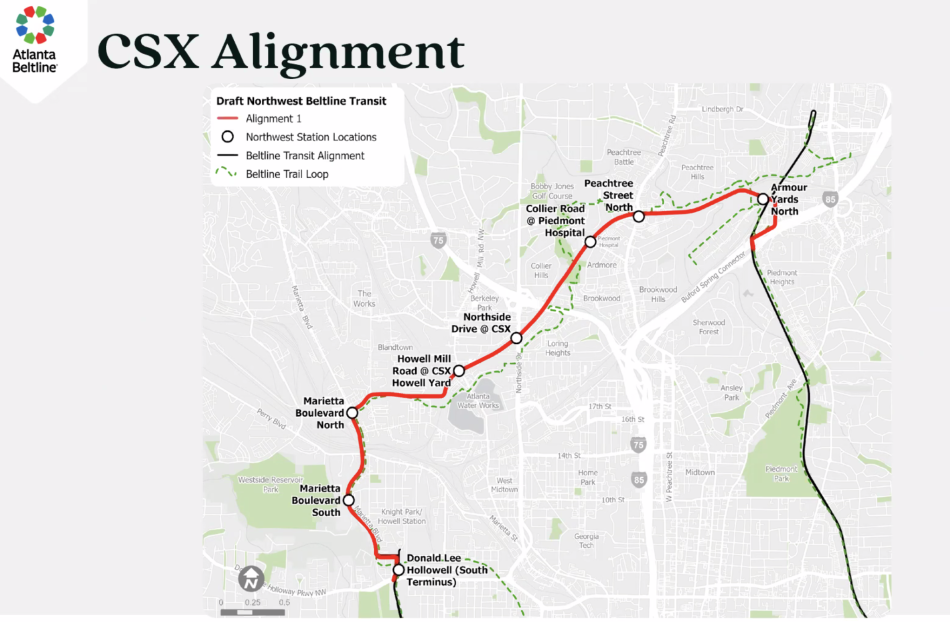 This transit route alongside CSX rail makes the most logistical and financial sense, per Beltline leadership. Atlanta Beltline Inc.
This transit route alongside CSX rail makes the most logistical and financial sense, per Beltline leadership. Atlanta Beltline Inc.
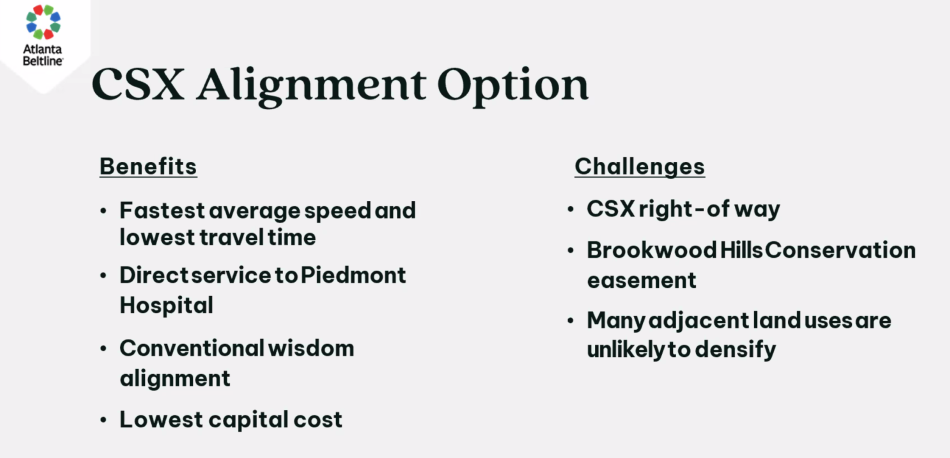 Hurdles for the CSX route include protected lands that would have to be avoided—and the fact that some sections have little potential to develop with more density (i.e., transit customers). Atlanta Beltline Inc.
Hurdles for the CSX route include protected lands that would have to be avoided—and the fact that some sections have little potential to develop with more density (i.e., transit customers). Atlanta Beltline Inc.
Atlanta Beltline Inc. kicked off the Beltline Transit Study in September 2023 to analyze the potential future of mobility around all sections of the 22-mile loop, excluding the northeast quadrant from Old Fourth Ward up to the Lindbergh area, where MARTA conducted its own transit study (to no avail, so far).
Not even a ballpark timeline for building Beltline transit has been established at this point, but Green said details about implementation should become clearer before the end of 2025, following more community engagement. Modeling work to help determine potential ridership is ongoing.
“[Mayor Andre Dickens] has said Beltline rail will start on the southside, but all else is unknown until the implementation plan is much further along,” said Green.
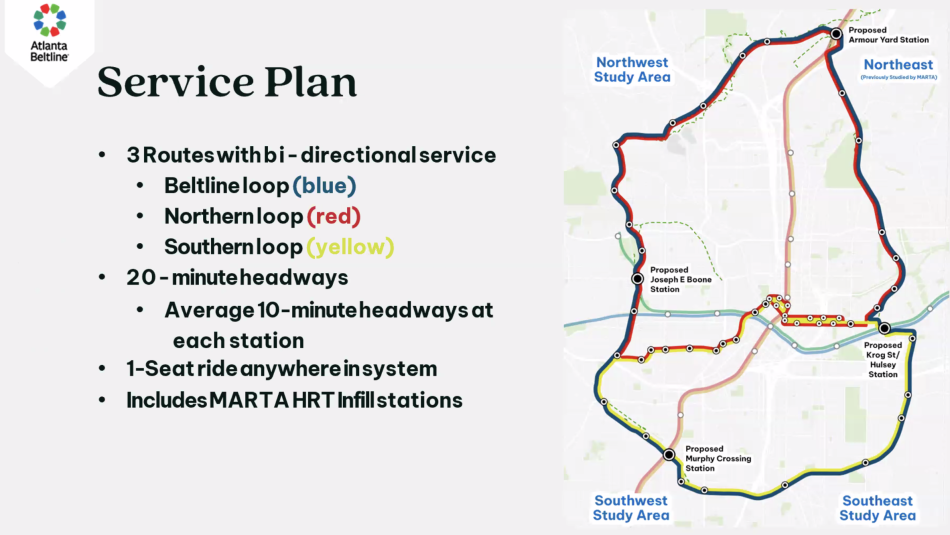 The Beltline's transit outlook actually calls for three loops—two of them incorporating a crosstown route—with service in both directions. Atlanta Beltline Inc.
The Beltline's transit outlook actually calls for three loops—two of them incorporating a crosstown route—with service in both directions. Atlanta Beltline Inc.
One factor that can’t be controlled or known, per Green, is future city leadership’s stance on Beltline transit and willingness to push it forward. But that, he indicated, should not be a hindrance for planning efforts today.
“Transit is not inexpensive,” said Green. “[But] it’s absolutely critical to the lifeblood of the system and the city.”
Find more visual highlights from the Beltline's presentation—in the order they were presented Tuesday—in the gallery above.
[UPDATE: 6:54 p.m., Aug. 13: Transit advocacy group Beltline Rail Now supplies the following statement regarding the Beltline Transit Study:
"Cue the orchestra and play something dreamy because until the city breaks ground on the shovel-ready Eastside Trail, the only thing they seem able to build are slide decks. Slide decks that paint a beautiful picture of Atlanta’s transit future, but deliver none of it.
We applaud the designers and transit teams. They’ve done an impeccable job planning the future of rail in Atlanta. But as the saga of the Eastside Trail makes clear, data and design don’t stand a chance against the Beltline politics of big-money developers who lobbied to kill rail.
We want to believe these latest plans are real. We want to believe they’ll become more than a PowerPoint fantasy. But how are we supposed to get swept up in the vision when Mayor Andre Dickens just announced his intention to scuttle the first phase of Beltline rail, the part that’s shovel-ready, fully funded, and could be in service by 2028?
The design is nearly complete. We’ve already spent $13 million on engineering. The money exists right now. And yet, we’re told to wait.
What we saw last night was a real plan for all 22 miles of Beltline rail and its east-west crosstown connectors. It includes cost estimates, infrastructure needs, and confirms that the Northwest segment should follow the Beltline corridor. It’s thoughtful. It’s ambitious. And it’s exactly what this city needs.
And let’s be clear: This is a light rail plan. Not buses. Not pods. Not gondolas. Not a high-speed parallel cycle track. It’s rail and that’s what the data has supported over and over again. Rail is the answer.
We’re calling on Dickens and his administration to step back up. Recommit to building the part of this system we can build now. Use the Beltline TAD and every available resource to fund the full design and engineering of this plan.
Let’s stop pretending we need another study. We need steel in the ground. We need tracks. We want to ride."]
...
Follow us on social media:
Twitter / Facebook/and now: Instagram
• Beltline news, discussion (Urbanize Atlanta)




